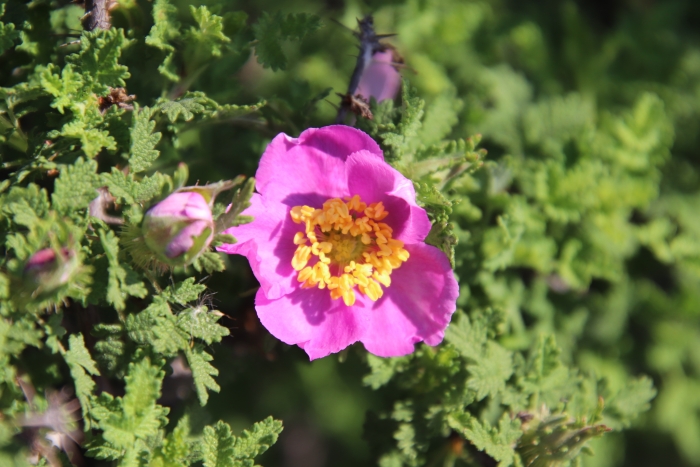Baja Rose
(Rosa minutifolia)
Baja Rose (Rosa minutifolia)
/
/

Millie Basden
CC BY 4.0
Image By:
Millie Basden
Recorded By:
Copyright:
CC BY 4.0
Copyright Notice:
Photo by: Millie Basden | License Type: CC BY 4.0 | License URL: http://creativecommons.org/licenses/by/4.0/ | Rights Holder: Millie Basden | Publisher: iNaturalist | Date Created: 2019-01-29T10:47:27-08:00 |
















Estimated Native Range
Summary
Rosa minutifolia, commonly known as Baja Rose, Baja Littleleaf Rose, or Small-leaved Rose, is a dense, thicket-forming perennial shrub native to the chaparral plant communities of northern Baja California and historically found in San Diego County, California. This species is particularly adapted to dry, rocky environments and coastal sage scrub. It typically forms a compact shrub up to 3 feet (1 meter) in height and width, with a notable abundance of small, glossy green leaves and a profusion of spiny stems that provide a deterrent to grazing animals.
Rosa minutifolia is valued for its drought tolerance and its ability to thrive with minimal water once established, making it suitable for xeriscaping and water-wise gardens. It produces charming pink flowers in the spring and winter, which are moderately showy and attract pollinators. The plant’s ability to defoliate under drought stress is a survival mechanism, allowing it to conserve resources. In cultivation, it is used for ornamental purposes, often in rock gardens, native plant landscapes, and as a barrier plant due to its dense and spiny nature. It requires full sun, low amounts of water, and well-drained soils. While it is exceptionally drought-tolerant, a thick layer of organic mulch can enhance its growth and flowering. Potential problems include susceptibility to rust and powdery mildew in humid conditions.CC BY-SA 4.0
Rosa minutifolia is valued for its drought tolerance and its ability to thrive with minimal water once established, making it suitable for xeriscaping and water-wise gardens. It produces charming pink flowers in the spring and winter, which are moderately showy and attract pollinators. The plant’s ability to defoliate under drought stress is a survival mechanism, allowing it to conserve resources. In cultivation, it is used for ornamental purposes, often in rock gardens, native plant landscapes, and as a barrier plant due to its dense and spiny nature. It requires full sun, low amounts of water, and well-drained soils. While it is exceptionally drought-tolerant, a thick layer of organic mulch can enhance its growth and flowering. Potential problems include susceptibility to rust and powdery mildew in humid conditions.CC BY-SA 4.0
Plant Description
- Plant Type: Shrub
- Height: 3-4 feet
- Width: 3-4 feet
- Growth Rate: Moderate
- Flower Color: Pink
- Flowering Season: Spring, Winter
- Leaf Retention: Semi-Deciduous
Growth Requirements
- Sun: Full Sun
- Water: Low
- Drainage: Fast
Common Uses
Bee Garden, Bird Garden, Butterfly Garden, Fragrant, Groundcover, Low Maintenance, Showy Flowers
Natural Habitat
Native to chaparral and coastal sage scrub communities of northern Baja California and historically San Diego County, California
Other Names
Common Names: Baja Littleleaf Rose, Small-Leaved Rose
Scientific Names: , Rosa minutifolia, Hesperhodos minutifolia,
GBIF Accepted Name: Rosa minutifolia Parry